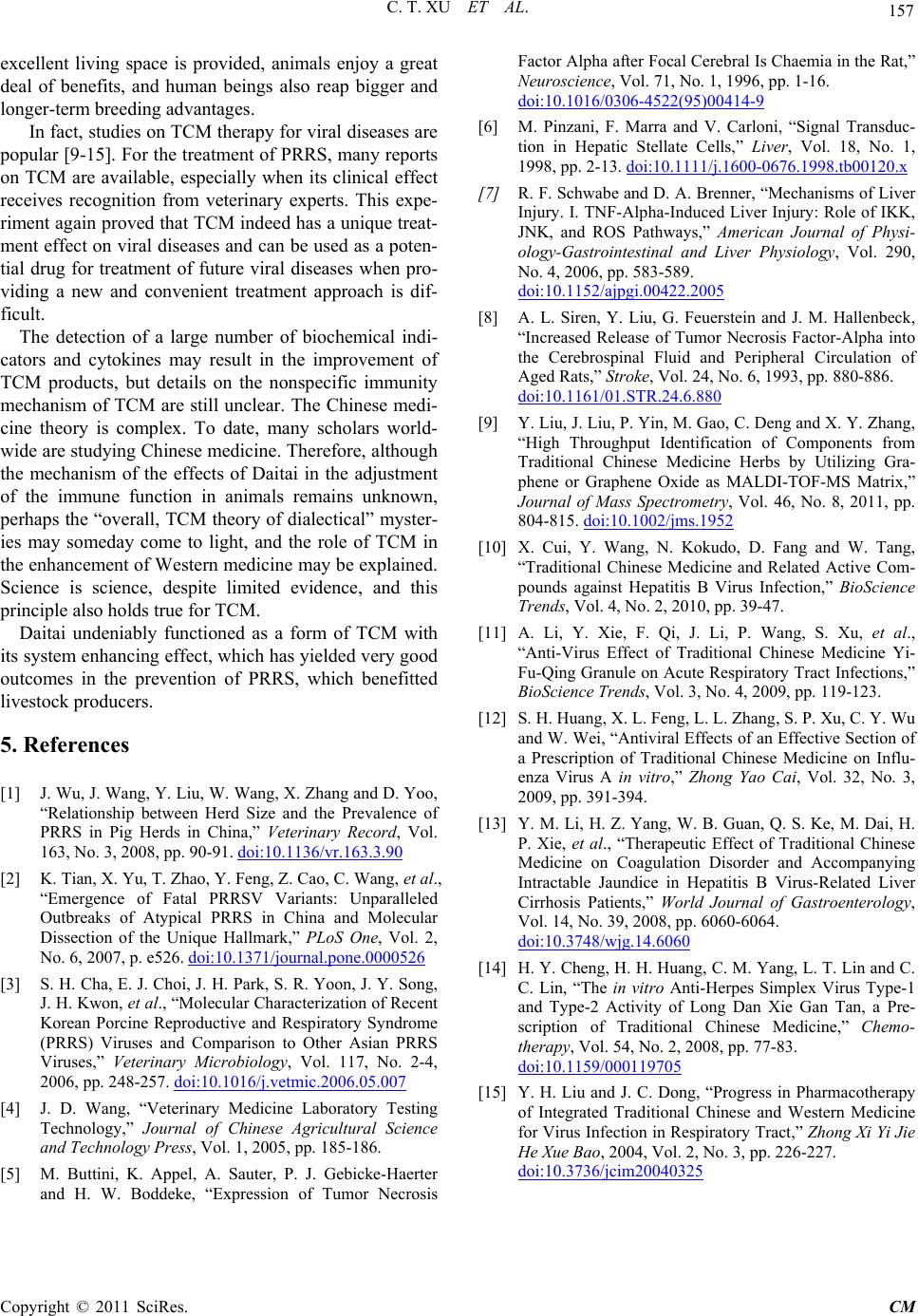
C. T. XU ET AL.
Copyright © 2011 SciRes. CM
157
excellent living space is provided, animals enjoy a great
deal of benefits, and human beings also reap bigger and
longer-term breeding advantages.
In fact, studies on TCM therapy for viral diseases are
popular [9-15]. For the treatment of PRRS, many reports
on TCM are available, especially when its clinical effect
receives recognition from veterinary experts. This expe-
riment again proved that TCM indeed has a unique treat-
ment effect on viral diseases and can be used as a poten-
tial drug for treatment of future viral diseases when pro-
viding a new and convenient treatment approach is dif-
ficult.
The detection of a large number of biochemical indi-
cators and cytokines may result in the improvement of
TCM products, but details on the nonspecific immunity
mechanism of TCM are still unclear. The Chinese medi-
cine theory is complex. To date, many scholars world-
wide are studying Chinese medicine. Therefore, although
the mechanism of the effects of Daitai in the adjustment
of the immune function in animals remains unknown,
perhaps the “overall, TCM theory of dialectical” myster-
ies may someday come to light, and the role of TCM in
the enhancement of Western medicine may be explained.
Science is science, despite limited evidence, and this
principle also holds true for TCM.
Daitai undeniably functioned as a form of TCM with
its system enhancing effect, which has yielded very good
outcomes in the prevention of PRRS, which benefitted
livestock producers.
5. References
[1] J. Wu, J. Wang, Y. Liu, W. Wang , X. Zha ng and D. Yoo ,
“Relationship between Herd Size and the Prevalence of
PRRS in Pig Herds in China,” Veterinary Record, Vol.
163, No. 3, 2008, pp. 90-91. doi:10.1136/vr.163.3.90
[2] K. Tian, X. Yu, T. Zhao, Y. Feng, Z. Cao, C. Wang, et al.,
“Emergence of Fatal PRRSV Variants: Unparalleled
Outbreaks of Atypical PRRS in China and Molecular
Dissection of the Unique Hallmark,” PLoS One, Vol. 2,
No. 6, 2007, p. e526. doi:10.1371/journal.pone.0000526
[3] S. H. Cha, E. J. Choi, J. H. Park, S. R. Yoon, J. Y. Song,
J. H. Kwon, et al., “Molecular Characterization of Recent
Korean Porcine Reproductive and Respiratory Syndrome
(PRRS) Viruses and Comparison to Other Asian PRRS
Viruses,” Veterinary Microbiology, Vol. 117, No. 2-4,
2006, pp. 248-257. doi:10.1016/j.vetmic.2006.05.007
[4] J. D. Wang, “Veterinary Medicine Laboratory Testing
Technology,” Journal of Chinese Agricultural Science
and Technology Press, Vol. 1, 2005, pp. 185-186.
[5] M. Buttini, K. Appel, A. Sauter, P. J. Gebicke-Haerter
and H. W. Boddeke, “Expression of Tumor Necrosis
Factor Alpha after Focal Cerebral Is Chaemia in the Rat,”
Neuroscience, Vol. 71, No. 1, 1996, pp. 1-16.
doi:10.1016/0306-4522(95)00414-9
[6] M. Pinzani, F. Marra and V. Carloni, “Signal Transduc-
tion in Hepatic Stellate Cells,” Liver, Vol. 18, No. 1,
1998, pp. 2-13. doi:10.1111/j.1600-0676.1998.tb00120.x
[7] R. F. Schwabe and D. A. Brenner, “Mechanisms of Liver
Injury. I. TNF-Alpha-Induced Liver Injury: Role of IKK,
JNK, and ROS Pathways,” American Journal of Physi-
ology-Gastrointestinal and Liver Physiology, Vol. 290,
No. 4, 2006, pp. 583-589.
doi:10.1152/ajpgi.00422.2005
[8] A. L. Siren, Y. Liu, G. Feuerstein and J. M. Hallenbeck,
“Increased Release of Tumor Necrosis Factor-Alpha into
the Cerebrospinal Fluid and Peripheral Circulation of
Aged Rats,” Stroke, Vol. 24, No. 6, 1993, pp. 880-886.
doi:10.1161/01.STR.24.6.880
[9] Y. Liu, J. Liu, P. Yin, M. Gao, C. Deng and X. Y. Zhang,
“High Throughput Identification of Components from
Traditional Chinese Medicine Herbs by Utilizing Gra-
phene or Graphene Oxide as MALDI-TOF-MS Matrix,”
Journal of Mass Spectrometry, Vol. 46, No. 8, 2011, pp.
804-815. doi:10.1002/jms.1952
[10] X. Cui, Y. Wang, N. Kokudo, D. Fang and W. Tang,
“Traditional Chinese Medicine and Related Active Com-
pounds against Hepatitis B Virus Infection,” BioScience
Trends, Vol. 4, No. 2, 2010, pp. 39-47.
[11] A. Li, Y. Xie, F. Qi, J. Li, P. Wang, S. Xu, et al.,
“Anti-Virus Effect of Traditional Chinese Medicine Yi-
Fu-Qing Granule on Acute Respiratory Tract Infections,”
BioScience Trends, Vol. 3, No. 4, 2009, pp. 119-123.
[12] S. H. Huang, X. L. Feng, L. L. Zhang, S. P. Xu, C. Y. Wu
and W. Wei, “Antiviral Effects of an Effective Section of
a Prescription of Traditional Chinese Medicine on Influ-
enza Virus A in vitro,” Zhong Yao Cai, Vol. 32, No. 3,
2009, pp. 391-394.
[13] Y. M. Li, H. Z. Yang, W. B. Guan, Q. S. Ke, M. Dai, H.
P. Xie, et al., “Therapeutic Effect of Traditional Chinese
Medicine on Coagulation Disorder and Accompanying
Intractable Jaundice in Hepatitis B Virus-Related Liver
Cirrhosis Patients,” World Journal of Gastroenterology,
Vol. 14, No. 39, 2008, pp. 6060-6064.
doi:10.3748/wjg.14.6060
[14] H. Y. Cheng, H. H. Huang, C. M. Yang, L. T. Lin and C.
C. Lin, “The in vitro Anti-Herpes Simplex Virus Type-1
and Type-2 Activity of Long Dan Xie Gan Tan, a Pre-
scription of Traditional Chinese Medicine,” Chemo-
therapy, Vol. 54, No. 2, 2008, pp. 77-83.
doi:10.1159/000119705
[15] Y. H. Liu and J. C. Dong, “Progress in Pharmacotherapy
of Integrated Traditional Chinese and Western Medicine
for Virus Infection in Respiratory Tract,” Zhong Xi Yi Jie
He Xue Bao, 2004, Vol. 2, No. 3, pp. 226-227.
doi:10.3736/jcim20040325